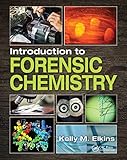Introduction to forensic chemistry / Kelly M. Elkins.
By: Elkins, Kelly M [author.] .
.
Material type:  BookPublisher: Boca Raton : CRC Press, Taylor and Francis Group, [2019]Description: xxx, 323 pages.ISBN: 9781032094632 (pbk).Subject(s): Chemistry, Forensic
BookPublisher: Boca Raton : CRC Press, Taylor and Francis Group, [2019]Description: xxx, 323 pages.ISBN: 9781032094632 (pbk).Subject(s): Chemistry, Forensic| Item type | Current location | Call number | Status | Date due | Barcode | Item holds |
|---|---|---|---|---|---|---|
 Books
Books
|
Learning Resource Center University of Management and Technology, Sialkot Iqbal Campus
|
542.3 ELK-I 2019 12553 (Browse shelf) | Available | 12553 |
Includes bibliographical references and index.
An introduction to forensic chemistry and physical evidence -- Chemical tests -- The microscope -- Light spectroscopy -- Advanced spectroscopy -- Chromatography -- Inorganic poisons and contaminants -- Controlled substances -- Toxicology -- Trace evidence -- Questioned documents and impression evidence -- Latent print development -- Firearms -- Arson and explosives -- Cbrne chemical, biological, radiological, nuclear and explosives -- Environmental forensics.
Forensic chemistry is a subdiscipline of forensic science, its principles guide the analyses performed in modern forensic laboratories. Forensic chemistry’s roots lie in medico-legal investigation, toxicology and microscopy and have since led the development of modern forensic analytic techniques and practices for use in a variety of applications.
Introduction to Forensic Chemistry is the perfect balance of testing methods and application. Unlike other competing books on the market, coverage is neither too simplistic, nor overly advanced making the book ideal for use in both undergraduate and graduate courses. The book introduces chemical tests, spectroscopy, advanced spectroscopy, and chromatography to students. The second half of the book addresses applications and methods to analyze and interpret controlled substances, trace evidence, questioned documents, firearms, explosives, environmental contaminants, toxins, and other topics. The book looks at innovations in the field over time including the latest development of new discernible chemical reactions, instrumental tools, methods, and more.
Key features:
Nearly 300 full-color figures illustrating key concepts and over 20 case studies
Addresses all the essential topics without extraneous or overly advanced coverage
Includes full pedagogy of chapter objectives, key terms, lab problems, end of chapter questions, and additional readings to emphasize key learning points
Includes chemical structures and useful spectra as examples
Fulfils the forensic chemistry course requirement in FEPAC-accredited programs
Includes a chapter on Chemical, Biological, Radiological, Nuclear, and Explosive (CBRNE) materials
Comprehensive and accessible, without being overly technical, Introduction to Forensic Chemistry will be a welcome addition to the field and an ideal text designed for both the student user and professor in mind.
Course ancillaries including an Instructor’s Manual with Test Bank and chapter PowerPoint® lecture slides are available with qualified course adoption.


There are no comments for this item.